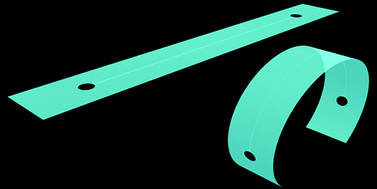An all-glass 12 μm ultra-thin and flexible micro-fluidic chip fabricated by femtosecond laser processing†
Abstract
This study investigated and established a method, using femtosecond laser processing, to fabricate a 100%-glass-based 12 μm ultra-thin and flexible micro-fluidic chip. First we investigated the suitable pulse energy of the laser to fabricate ultra-thin glass sheets and then we fabricated a prototype glass micro-fluidic chip. Two 1 mm-in-diameter orifices for facilitating alignment in the bonding step and one channel with a width of 20 μm and a length of 25 mm were fabricated in a 4 μm thickness ultra-thin glass sheet using the femtosecond laser; this forms layer 2 in the completed device. Next, the glass sheet with the channel was sandwiched between another glass sheet having an inlet hole and an outlet hole (layer 1) and a base glass sheet (layer 3); the three sheets were bonded to each other, resulting in a flexible, 100%-glass micro-fluidic chip with a thickness of approximately 12 μm and a weight of 3.6 mg. The basic function of the glass micro-fluidic chip was confirmed by flowing 1 and 2 μm in-diameter bead particles through the channel. The fabrication method clearly scales down the thickness limitation of flexible glass devices and offers a possible element technology for fabricating ultra-thin glass devices that can be applied to convection-enhanced delivery, implantable medical devices, wearable devices, and high-resolution imaging of small biological objects such as bacteria and proteins in the channel.


 Please wait while we load your content...
Please wait while we load your content...